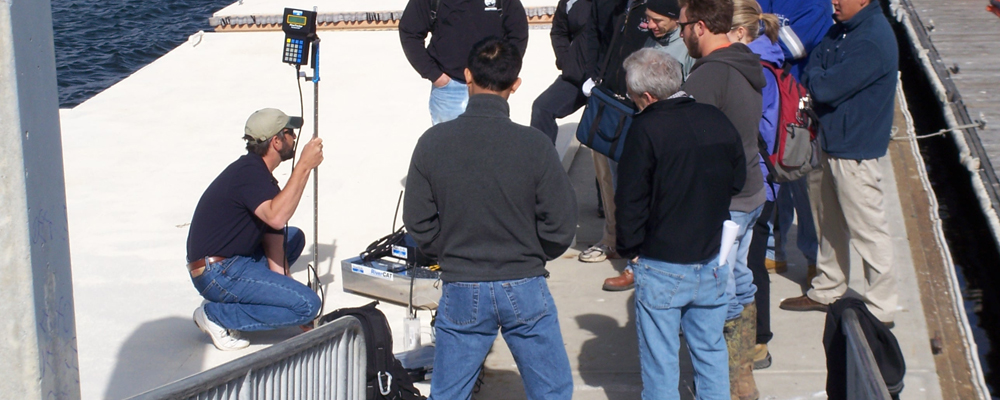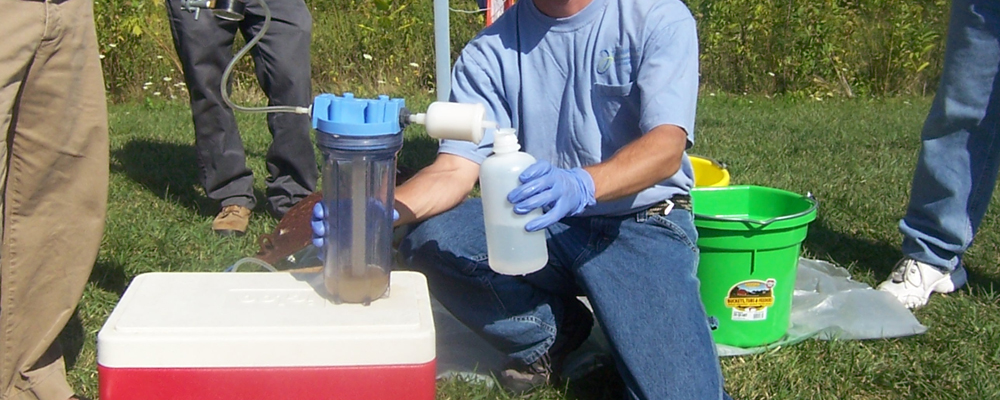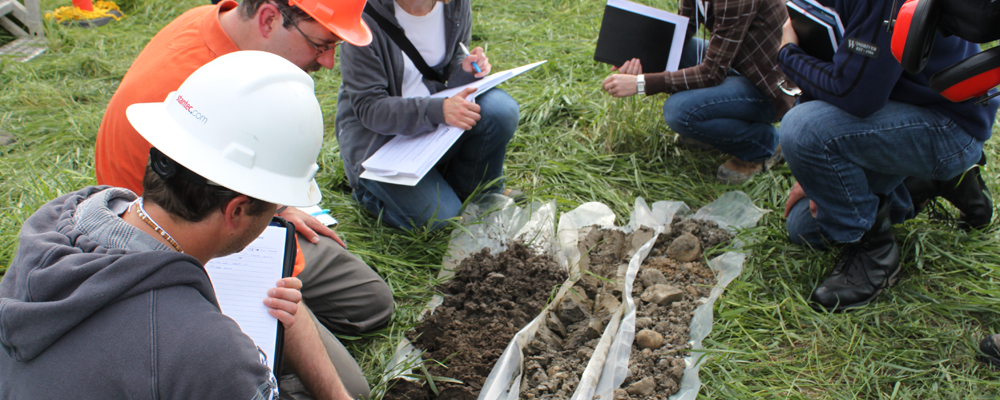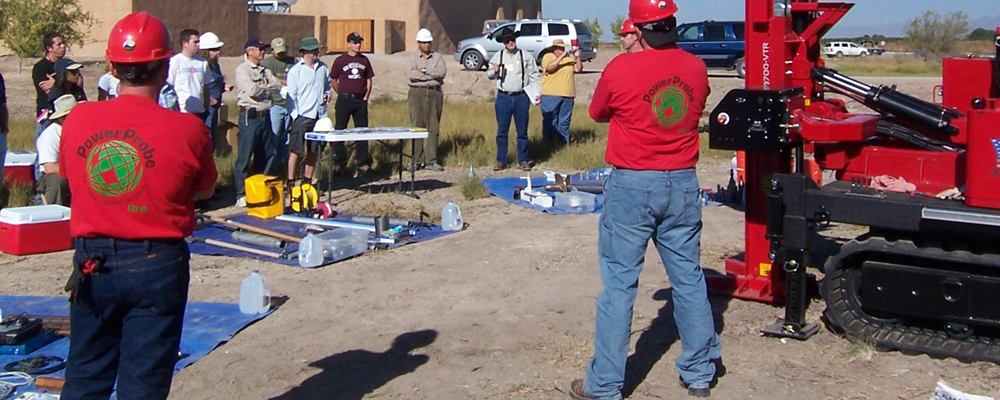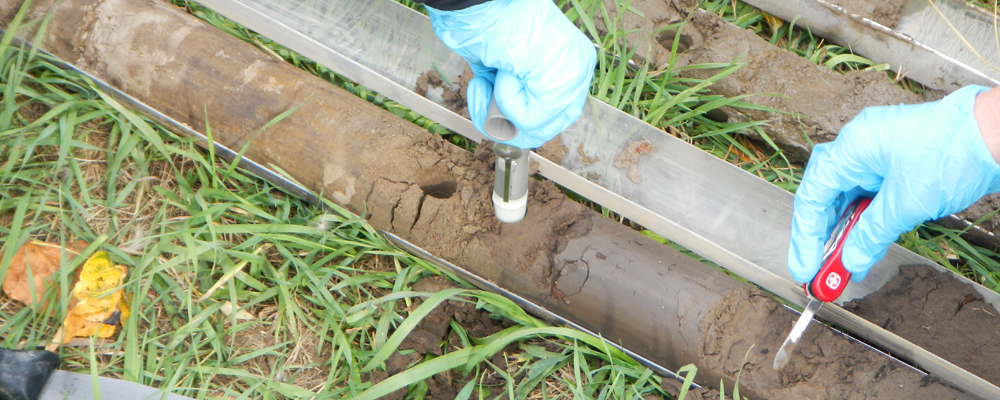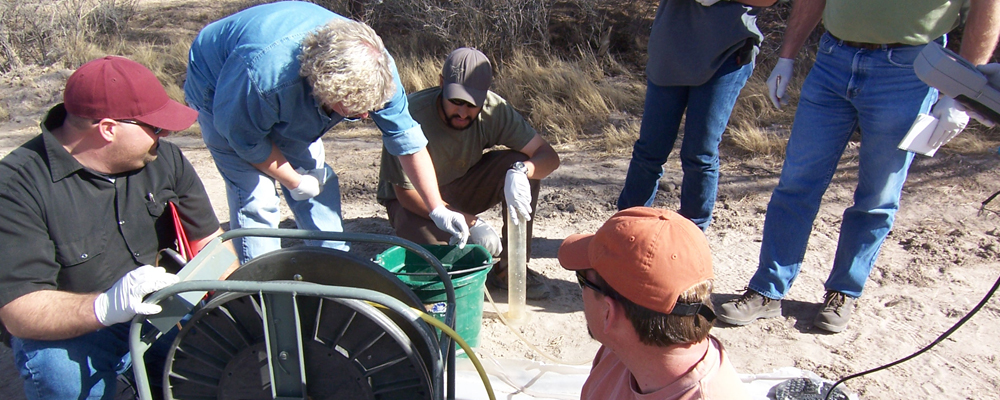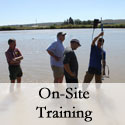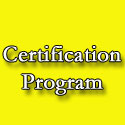Topic: The Science Behind Soil Sampling
Soil sampling – as easy as digging a hole and grabbing some dirt, isn’t it? No, it’s not! This series of 3 modules explores the nuances of soils and how they affect soil sample collection. The first module begins by explaining the importance of developing an understanding of the complexity of soils and their parent geologic materials, then addresses the correlation between site geology and contaminant movement through the unsaturated (vadose) zone and the saturated zone. With these fundamental concepts in place, discussions focus on how this complex relationship affects how and where soils should be sampled to ensure that objectives for both physical and chemical sample analysis can be met by the sampling program. This module then builds upon the concept of developing a detailed 3-dimensional view of subsurface materials, and walks you through everything that needs to be addressed when planning a soil sampling program, including defining what a representative soil sample is. The second module addresses the differences between conventional (multi-phased) site characterization and accelerated/expedited site characterization, and how to use accelerated site characterization methods to accomplish more comprehensive, cost-effective and efficient site characterization programs. The third module covers the use of a variety of site-characterization tools (direct-push, sonic drilling, cone penetration testing and field analytical methods) and concludes by addressing the questions of how many soil borings should be installed, at what depth intervals samples should be taken, and how many samples are enough for any given project. While you may opt to take just one of these modules, it is strongly recommended that you take all three modules in the prescribed order if you want comprehensive coverage of the subject.
Module SS–06 (Total Length: 59 minutes)
The Science Behind Soil Sampling – Part 1
- Understanding the Heterogeneous Nature of Soils and Their Parent Geologic Materials
- How Variations in Soil Type and Grain Size Affect the Movement of Water and Contaminants in the Vadose (Unsaturated) Zone and Saturated Zone
- Major Causes of Soil Heterogeneity
- Why it is Important to Understand the Complexity of Soil Samples and How That Complexity Affects Soil Sample Collection and Handling
- Planning a Soil Sampling Program
- Overview of Typical Soil Sampling Objectives
- Definitions of Representative Samples for Physical vs. Chemical Analysis at the Sample Scale and the Site Scale
Module SS–07 (Total Length: 63 minutes)
The Science Behind Soil Sampling – Part 2
- The Conventional Environmental Site Characterization Approach: Multi-Phased Sampling
- Improved Approaches to Environmental Site Characterization: Accelerated and Expedited Site Characterization
- Cost and Efficiency Benefits of Accelerated/Expedited Site Characterization vs. Conventional Multi-Phased Sampling
Module SS–08 (Total Length: 49 minutes)
The Science Behind Soil Sampling – Part 3
- Methodologies and Technologies Used in Accelerated/Expedited Site Characterization
- Direct-Push Technology
- Sonic Drilling
- Cone Penetration Testing
- Field Analytical Methods
- Summary of Improved Site Characterization Using the Accelerated/Expedited Approach
- Determining How Many Boreholes to Install, What Depth Intervals to Sample, and How Many Samples to Collect
Total CEUs for Module SS-06: 1 CEU
Total CEUs for Module SS-07: 1.1 CEUs
Total CEUs for Module SS-08: 1 CEU
Topic: Selection and Use of Soil Sampling Equipment
At least a dozen different kinds of soil sampling devices are available for you to use for the collection of soil samples – some can be manually deployed (simple and cost-effective, but limited to shallow depths), and others must be mechanically deployed (more complex and expensive, but with greater depth capability). Some devices can be used to collect depth-discrete samples, while others can be used for continuous sampling. Not all devices are suited to all field conditions, and some devices are better than others for collecting soil samples that are destined for chemical analysis. This series of two modules discusses the factors that affect the selection of an appropriate soil sampling device or method for prevailing site conditions and site-specific sampling objectives. These modules discuss in detail the options for hand-operated devices such as push tubes and hand augers, through mechanically deployed devices used in conjunction with portable drive sources, direct-push rigs and several different types of drilling rigs. The use of supplemental accessories such as sample retainers and liners is also discussed in detail. While you may opt to take just one of these modules, it is strongly recommended that you take both modules in the prescribed order if you want comprehensive coverage of the subject.
Module SS-09 (Total Length: 62 minutes)
Selection and Use of Soil Sampling Equipment – Part 1
- Factors Affecting the Selection of an Appropriate Soil Sampling Method
- Selecting a Sampling Device to Suit Site-Specific Field Conditions
- Overview, Applications & Limitations of Hand-Operated Devices (Push Tubes and Hand Augers)
- Overview, Applications and Limitations of Devices Used with Direct-Push Rigs for Discrete and Continuous Soil Sampling
Module SS-10 (Total Length: 85 minutes)
Selection and Use of Soil Sampling Equipment – Part 2
- Overview, Applications and Limitations of Mechanically Assisted Devices (Split-Spoon Samplers, Thin-Wall Tube Samplers, Continuous Tube Samplers) Used with Drilling Rigs
- Solid Stem Augers
- Mud-Rotary Drilling
- Sonic Drilling
- Hollow-Stem Augers
- Pros and Cons of Using Soil Sample Liners and Sample Retainers
Total CEUs for Module SS-09: 1 CEU
Total CEUs for Module SS-10: 1.4 CEUs
Topic: Soil Sample Handling and Processing Using U.S. EPA Method 5035B
Traditional methods of soil sample collection and handling for volatile organic compound (VOC) analysis are fraught with error and result in negative bias associated with data generated by laboratory analysis of these soil samples. This series of two modules explains why collecting soil samples for VOCs using “zero headspace” techniques is not valid and may, in fact, introduce significant bias and error; how conventional bulk matrix sampling practices can result in biased samples; and why laboratory subsampling of soil samples introduces error. Learn how proper implementation of U.S. EPA Method 5035B will result in collection and analysis of samples that much more accurately reflect in-situ field conditions and will result in much more accurate data. While Method 5035B is not a “new” method in the U.S., it is being increasingly adopted in countries other than the U.S. Unfortunately, both in the U.S. and Internationally the method is widely misunderstood and is often poorly implemented in the field. This series of two modules uses a comprehensive series of classroom and field videos to provide definitive guidance on what the intent of Method 5035B is, how to correctly implement both volumetric sampling methods and chemical preservation/extraction methods in the field, and how to avoid common field errors when implementing Method 5035B that can result in either negative or positive biases (or both) during sampling. Correct field procedures are illustrated through the use of “how-to” field videos. While you may opt to take just one of these modules, it is strongly recommended that you take both modules in the prescribed order if you want comprehensive coverage of the subject.
Module SS-11 (Total Length: 50 minutes)
Soil Sample Handling and Processing Using U.S. EPA Method 5035B – Introduction; Use of Volumetric Sample Collection Methods
- How Volatiles are Lost From Soil Samples
- Problems With Traditional Soil Sampling Methods for VOCs
- Limitations of Using Liners for VOC Sample Collection
- Objectives of Method 5035B
- Volumetric Sample Collection – How it Works, Equipment Options, Common Errors
- ASTM Standard Practice D 6418 for Using EnCore Samplers
- Advantages and Limitations of Volumetric Sample Collection Methods
Module SS-12 (Total Length: 52 minutes)
Soil Sample Handling and Processing Using U.S. EPA Method 5035B – Use of Chemical Preservation/Extraction Methods
- Chemical Preservation/Extraction Techniques for Low-Level Sample Preparation and Preservation
- Chemical Preservation/Extraction Techniques for High-Level Sample Preparation and Preservation
- Overview of U.S. EPA Method 3815 to Select High-Level or Low-Level Preservation Methods
- Advantages and Limitations of Chemical Preservation/Extraction Methods
Total CEUs for Module SS-11: 1 CEU
Total CEUs for Module SS-12: 1 CEU
Topic: Field Sample Analysis Options for Soil Samples
Historically, field analysis of environmental samples has yielded numbers that, in many cases, were not regarded as being truly quantitative analytical data but were considered to be more qualitative in nature – a “yes/no” indicator of whether or not a chemical constituent was present. Over the past decade, there have been tremendous advances in the types and level of accuracy of field analytical tools available for the field chemist and non-chemist alike. In many cases, these new tools can provide quantitative data that can be used to accurately characterize the presence, absence and levels of specific contaminants in the subsurface. This module describes how to design an effective field analytical program from the non-chemist’s perspective and provides guidance on how to ensure that data generated are both accurate and defensible. In-depth discussions are provided to address how to select the best parameters, analytical instruments and methods to meet the objectives of a field analytical program. This module also provides an overview of analytical instruments and methods available for volatile, semi-volatile and non-volatile contaminants commonly of interest in environmental site investigation and characterization programs.
Module SS-13 (Total Length: 78 minutes)
Field Sample Analysis Options for Soil Samples
- Problems with Historical Approaches to Field Sample Screening
- The Role of U.S. EPA’s Triad Program and ITRC in Getting New Technologies Into the Field
- How to Ensure That Field Analytical Data Will be Accepted by Regulatory Agencies
- Field and Administrative Factors to Consider When Developing a Field Sample Analysis Program
- Common Objectives of Field Sample Analysis
- Selection Criteria for Choosing Field Analytical Instruments and Methods for the Non-Chemist
- Overview of Field Analytical Instruments and Methods for Volatile Compounds, Including Headspace Screening of Soil Samples
- Soil Sample Extraction and Field Analytical Methods for Semi-Volatile Compounds
- Direct Sample Analysis Methods for Non-Volatile Compounds Such as Metals
Total CEUs for Module SS-13: 1.3 CEUs
Topic: Field Equipment Decontamination Procedures for Soil Sampling
Soil sampling equipment falls into one of two categories – equipment that is manually operated and equipment that is deployed using a portable drive source, or a direct-push or drilling rig. Most soil sampling equipment is designed and built to be reused, so it is a common practice to deploy the same soil sampling equipment at multiple sampling locations. This is certainly convenient, but introduces the potential for cross-contamination of sampling locations and individual samples, both of which may affect the representative nature of samples collected. To prevent this potentially very serious and costly problem, it is critical to implement thorough and effective field equipment cleaning protocols. This module discusses in detail field equipment cleaning protocols that apply to equipment used for sampling soil, both sample-contacting equipment and equipment that facilitates sample collection but doesn’t contact the sample. Learn how decontamination procedures may vary according to the sampling equipment being used and by the contaminants being analyzed in samples. Discover why a few of the “detergents” commonly used for field equipment cleaning should be avoided for some field applications because they may contain phosphates, and why others may introduce trace amounts of semi-volatile compounds if not diluted sufficiently. You will also learn important terminology such as the differences between portable, dedicated, designated and disposable field equipment.
Module SS-04 (Total Length: 68 minutes)
Field Equipment Decontamination Procedures for Soil Sampling
- Purposes of Field Equipment Decontamination
- Considerations for Selection of an Effective Field Decontamination Protocol
- Discussion of ASTM Standards D 5088 and D 5608 on Field Equipment Decontamination
- Control Water – Understanding the Term and How it Affects Decon Water Selection for Various Contaminants and Equipment
- Dedicated vs. Designated vs. Portable vs. Disposable Equipment – Understanding the Differences and Building Them Into Your Cleaning Protocols
- Problems Associated With Using Chemical Desorbing Agents
- QA/QC Elements of Equipment Cleaning Programs
- Avoiding Common Errors in the Field During Equipment Cleaning
Total CEUs for Module SS-04: 1.1 CEUs
Topic: Field Quality Assurance/Quality Control Practices for Soil Sampling
You think your sampling team does a good job in the field, but how can you be sure, and have the confidence that the results they produce are valid and defensible? With many soil sampling programs, it is not unusual to have more than one sampling team, sometimes from more than one company, in the field collecting soil samples. When this is the case, you want to make sure the data generated in the field and in the laboratory are comparable. How do you do that? With sound field QA/QC procedures! Learn how to ensure that your sampling practices are technically and legally defensible and how to prove to outside groups and auditors that the data being generated during a sampling event can be validated. This module explains in detail how to implement an effective field QA/QC program designed for soil sampling, how to select the most meaningful QC samples for soil samples, how to correctly collect the chosen QC samples, how many to collect, and how to interpret the results.
Module SS-05 (Total Length: 41 minutes)
Field Quality Assurance/Quality Control Practices for Soil Sampling
- Understanding the Difference Between Quality Assurance and Quality Control
- Why Field QA/QC is so Important and How Much QA/QC do You Need?
- Determining Which QC Samples Should be Used for Soil Sampling and Why
- Selecting Parameters to Run on QC Samples
- Detailed Discussions of the Types of QC Samples to Incorporate Into a Soil Sampling Event
- How to Correctly Collect QC Samples for Soil While Avoiding Common Errors in the Field
- Determining How Many QC Samples to Collect
Total CEUs for Module SS-05: 1 CEU
Topic: Soil Sample Collection, Description & Handling in the Field
During drilling of boreholes for site characterization and monitoring well installation, soil samples must be collected at the site to document site-specific geologic conditions in the subsurface. These soil samples are used to develop a detailed understanding of site hydrogeology, to determine the presence/absence of contamination, to determine the location, physical and chemical characteristics of target monitoring zones in which wells will be installed, and to design well screens and filter packs. This series of two modules uses a comprehensive series of classroom and field videos to provide instruction on proper procedures for collection of soil samples for both physical and chemical analysis, parameters and techniques for detailed physical soil sample description, and proper handling of soil samples during sampling events. While you may opt to take just one of these modules, it is strongly recommended that you take both modules in the prescribed order if you want comprehensive coverage of the subject.
Module SS-14 (Total Length: 65 minutes)
Soil Sample Collection, Description & Handling in the Field -- Planning and Preparation for Soil Sample Collection and Description; Describing Soil Samples in the Field (Part 1)
- Objectives of Soil Sample Description
- Important Principles Applied in Soil Sample Description
- Preparing for a Soil Sampling Event
- Items to Discuss With the Drilling/Direct-Push Contractor Prior to Mobilizing to the Site
- Equipment and Materials Recommended for Soil Sample Description and Handling
- Checklists for Soil Sample Description in the Field
- Soil Classification Systems – USCS (ASTM Standards D 2487 and D 2488), USDA and Others
- Describing Soil Samples – 26 Physical Sample Descriptors to Record (Part 1)
- Grain Size, Degree of Sorting, Particle Angularity/Roundness/Shape, Mineralogy, Density/Consistency, Plasticity/Cohesiveness, Moisture Content, Color (Including Use of Munsell Soil Color Charts)
Module SS-15 (Total Length: 85 minutes)
Soil Sample Collection, Description & Handling in the Field -- Describing Soil Samples in the Field (Part 2); Handling Soil Samples in the Field
- Describing Soil Samples – 26 Physical Sample Descriptors to Record (Part 2)
- Sedimentary Features, Presence of Macropores, Redox Conditions, Organic Matter, Degree of Weathering, Carbonate Content, and Other Descriptors
- Handling Soil Samples During the Sampling Event
- Samples Used for Physical Analysis
- Samples Used for Chemical Analysis
Total CEUs for Module SS-14: 1.1 CEUs
Total CEUs for Module SS-15: 1.4 CEUs
Topic: Soil Sample Handling and Shipment
Your soil samples may have been collected using the highest degree of care, but your job is still not complete – the samples need to get to the laboratory in good condition, on time and in compliance with shipping regulations. This module discusses options available for sample delivery to the laboratory, dealing with awkward samples that pose shipping difficulties, and how to ship samples that are classified as being hazardous under shipping regulations. You will learn about tamper-proofing mechanisms that should be used in many projects to protect the physical and chemical integrity of your samples, and learn why U.S. EPA’s definition of “hazardous” does not necessarily agree with shipping regulation definitions of hazardous. Learn why you need to know about IATA and DOT shipping regulations and why you need to be certified to ship hazardous environmental samples.
Module SS-16 (Total Length: 70 minutes)
Soil Sample Handling and Shipment
- Special Problems Encountered When Shipping Soil and Rock Samples
- Options for Getting Samples From the Field to the Laboratory
- Preparing for Sample Shipment
- Discussion of ASTM Standard D 6911 on Packaging and Shipping Environmental Samples for Laboratory Analysis
- Mechanisms to Protect Samples From Tampering During a Sampling Event and Shipment to the Laboratory
- Understanding the Role of Chain-of-Custody Forms – Their Purpose, When and How They Should be Completed
- Overview of DOT and IATA Shipping Regulations and How These Regulations Affect Getting Samples to the Laboratory
- How to Correctly Pack a Cooler Containing Uncontaminated Samples for Delivery
- What Happens to Samples When They Arrive at the Laboratory
Total CEUs for Module SS-16: 1.2 CEUs
Topic: Sampling Event Documentation
Document… document… document! Paperwork is the part of a sampling event that sampling teams hate the most! This module explains in detail the various mechanisms available for documenting field activities, taken from the approach of ensuring that mechanisms are in place to make certain that field documentation that is both traceable and defensible. The three key options for field recordkeeping - written records, electronic records and audio-visual records - are discussed in detail in this module. This module is appropriate not only for sampling team members but also for regulatory personnel who may be involved in enforcement cases that require the collection of evidence for court cases.
Module SS–17 (Total Length: 92 minutes)
Sampling Event Documentation
- Detailed Discussion of the Secrets to Keeping Written Records
- Types of Written Records to Address in the Sampling & Analysis Plan
- Field Forms – Pros and Cons of Loose Forms
- Site-Specific Bound Field Notebooks
- What to Record and What Not to Record in Your Field Notes
- Overview of ASTM Standard Guide D 6089 on Documentation of Environmental Sampling Events
- Avoiding Common Errors in Recording Written Notes in the Field
- Use of Error Codes in Field Notes When an Error is Made
- Electronic Recordkeeping
- Advantages and Limitations of Electronic Information Recording
- Managing E-Documents in the Field and in the Office
- Think Twice Before Sending That E-Mail
- Audio-Visual Recordkeeping
- Getting Written Approvals
- Audio Recordings – Do’s and Don’ts
- The Great Debate: Digital vs. Print Film Cameras
- Camera Lens Considerations
- Video Cameras – to Use or Not to Use?
Total CEUs for Module SS-17: 1.5 CEUs

